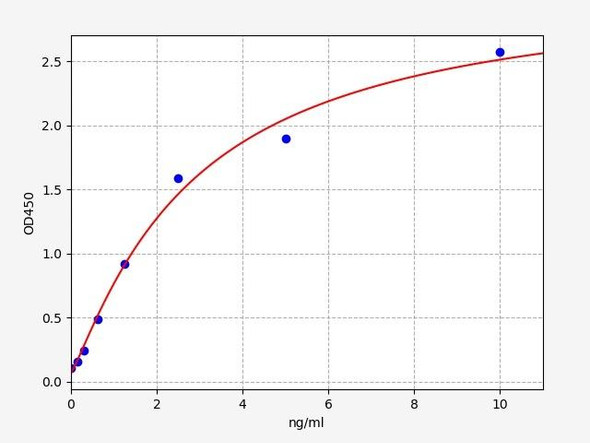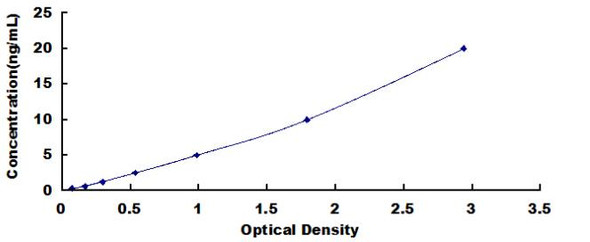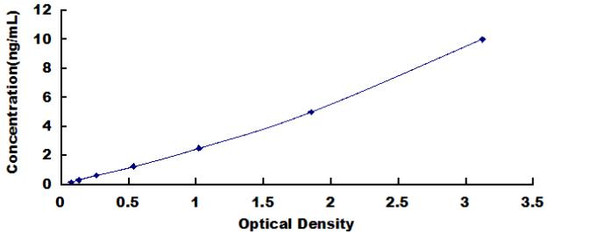Description
Human Histone deacetylase 1 (HDAC1) ELISA Kit
The Human Histone Deacetylase-1 (HDAC1) ELISA Kit is specifically designed for the accurate detection of HDAC1 levels in human samples, including serum, plasma, and cell culture supernatants. This kit offers high sensitivity and specificity, ensuring precise and reliable results for a variety of research applications.HDAC1 is an important enzyme involved in regulating gene expression by modifying chromatin structure. Dysregulation of HDAC1 has been implicated in various diseases, including cancer, neurodegenerative disorders, and inflammatory conditions.
As such, measuring HDAC1 levels can provide valuable insights into the pathogenesis of these diseases and aid in the development of targeted therapies.By utilizing the Human HDAC1 ELISA Kit, researchers can effectively study the role of HDAC1 in disease progression and assess the efficacy of potential HDAC1-targeted interventions. This kit offers a convenient and efficient method for investigating the impact of HDAC1 on cellular function and disease pathology, ultimately advancing our understanding of HDAC1 biology and its therapeutic potential.
| Product Name: | Human Histone deacetylase 1 (HDAC1) ELISA Kit |
| SKU: | HUEB0891 |
| Size: | 96T |
| Target: | Human Histone deacetylase 1 (HDAC1) |
| Synonyms: | HD1, RPD3L1 |
| Assay Type: | Sandwich |
| Detection Method: | ELISA |
| Reactivity: | Human |
| Detection Range: | 0.235-15ng/mL |
| Sensitivity: | 0.117ng/mL |
| Intra CV: | 6.7% | ||||||||||||||||||||
| Inter CV: | 10.3% | ||||||||||||||||||||
| Linearity: |
| ||||||||||||||||||||
| Recovery: |
| ||||||||||||||||||||
| Function: | Responsible for the deacetylation of lysine residues on the N-terminal part of the core histones (H2A, H2B, H3 and H4). Histone deacetylation gives a tag for epigenetic repression and plays an important role in transcriptional regulation, cell cycle progression and developmental events. Histone deacetylases act via the formation of large multiprotein complexes. Deacetylates SP proteins, SP1 and SP3, and regulates their function. Component of the BRG1-RB1-HDAC1 complex, which negatively regulates the CREST-mediated transcription in resting neurons. Upon calcium stimulation, HDAC1 is released from the complex and CREBBP is recruited, which facilitates transcriptional activation. Deacetylates TSHZ3 and regulates its transcriptional repressor activity. Deacetylates 'Lys-310' in RELA and thereby inhibits the transcriptional activity of NF-kappa-B. Deacetylates NR1D2 and abrogates the effect of KAT5-mediated relieving of NR1D2 transcription repression activity. Component of a RCOR/GFI/KDM1A/HDAC complex that suppresses, via histone deacetylase (HDAC) recruitment, a number of genes implicated in multilineage blood cell development. Involved in CIART-mediated transcriptional repression of the circadian transcriptional activator: CLOCK-ARNTL/BMAL1 heterodimer. Required for the transcriptional repression of circadian target genes, such as PER1, mediated by the large PER complex or CRY1 through histone deacetylation. |
| Uniprot: | Q13547 |
| Sample Type: | Serum, plasma, tissue homogenates, cell culture supernates and other biological fluids |
| Specificity: | Natural and recombinant human Histone deacetylase 1 |
| Sub Unit: | Part of the core histone deacetylase (HDAC) complex composed of HDAC1, HDAC2, RBBP4 and RBBP7. The core complex associates with MTA2, MBD2, MBD3, MTA1L1, CHD3 and CHD4 to form the nucleosome remodeling and histone deacetylation (NuRD) complex, or with SIN3, SAP18 and SAP30 to form the SIN3 HDAC complex. Component of a BHC histone deacetylase complex that contains HDAC1, HDAC2, HMG20B/BRAF35, KDM1A, RCOR1/CoREST and PHF21A/BHC80. The BHC complex may also contain ZMYM2, ZNF217, ZMYM3, GSE1 and GTF2I. Component of a mSin3A corepressor complex that contains SIN3A, SAP130, SUDS3/SAP45, ARID4B/SAP180, HDAC1 and HDAC2. Found in a trimeric complex with APBB1 and TSHZ3; the interaction between HDAC1 and APBB1 is mediated by TSHZ3. Component of a RCOR/GFI/KDM1A/HDAC complex. Part of a complex composed of TRIM28, HDAC1, HDAC2 and EHMT2. Part of a complex containing at least CDYL, MIER1, MIER2, HDAC1 and HDAC2. The large PER complex involved in the histone deacetylation is composed of at least HDAC1, PER2, SFPQ and SIN3A. Associates with the 9-1-1 complex; interacts with HUS1. Found in a complex with DNMT3A and HDAC7. Interacts with the non-histone region of H2AFY. Interacts with TRIM28; the interaction recruits HDAC1 to E2F1 and inhibits its acetylation. Interacts with SP1; the interaction deacetylates SP1 and regulates its transcriptional activity. Interacts with SP3; the interaction deacetylates SP3 and regulates its transcriptional activity. In vitro, C(18) ceramides increase this interaction and the subsequent SP3 deacetylation and SP3-mediated repression of the TERT promoter. Interacts with TSHZ3 (via N-terminus); the interaction is direct. Interacts with APEX1; the interaction is not dependent on the acetylated status of APEX1. Interacts with C10orf90/FATS (via its N-terminal); the interaction prevents binding of HDAC1 to CDKN1A/p21 and facilitates the acetylation and stabilization of CDKN1A/p21. Interacts with CDKN1A/p21. Interacts with CDK5 complexed to CDK5R1 (p25). Interacts directly with GFI1 and GFI1B. Interacts with NR1D2 (via C-terminus). Interacts with TSC22D3 isoform 1; this interaction affects HDAC1 activity on MYOG promoter and thus inhibits MYOD1 transcriptional activity. Interacts with BAZ2A/TIP5, BANP, BCL6, BCOR, BHLHE40/DEC1, BRMS1, BRMS1L, CBFA2T3, CHFR, CIART, CRY1, DAXX, DDIT3/CHOP, DDX5, DNMT1, E4F1, EP300, HCFC1, HDAC9, INSM1, NFE4, NR4A2/NURR1, MIER1, KDM4A, KDM5B, KLF1, MINT, NRIP1, PCAF, PHB2, PRDM6, PRDM16, RB1, RERE, SAMSN1, SAP30L, SETDB1, SMAD3, SMARCA4/BRG1, SMYD2, SUV39H1, TGIF, TGIF2, TRAF6, UHRF1, UHRF2, ZMYND15, ZNF431 and ZNF541. Interacts with KDM5A (By similarity). Interacts with DNTTIP1 (PubMed:25653165). Identified in a histone deacetylase complex that contains DNTTIP1, HDAC1 and ELMSAN1; this complex assembles into a tetramer that contains four copies of each protein chain (PubMed:25653165). Interacts with CCAR2 (PubMed:21030595). Interacts with PPHLN1 (PubMed:17963697). Found in a complex with YY1, SIN3A and GON4L (By similarity). Interacts with CHD4 (PubMed:27616479). |
| Research Area: | Neurosciences |
| Subcellular Location: | Nucleus |
| Storage: | Please see kit components below for exact storage details |
| Note: | For research use only |
| UniProt Protein Function: | HDAC1: a transcriptional regulator of the histone deacetylase family, subfamily 1. Deacetylates lysine residues on the N-terminal part of the core histones H2A, H2B, H3 AND H4. Plays an important role in transcriptional regulation, cell cycle progression and developmental events. |
| UniProt Protein Details: | Protein type:Nuclear receptor co-regulator; EC 3.5.1.98; Hydrolase Chromosomal Location of Human Ortholog: 1p34 Cellular Component: chromatin; cytoplasm; cytosol; histone deacetylase complex; nuclear chromatin; nucleoplasm; nucleus; NuRD complex; protein complex; Sin3 complex Molecular Function:deacetylase activity; enzyme binding; histone deacetylase activity; histone deacetylase binding; NF-kappaB binding; nucleosomal DNA binding; protein binding; protein deacetylase activity; protein N-terminus binding; transcription activator binding; transcription factor activity; transcription factor binding Biological Process: ATP-dependent chromatin remodeling; blood coagulation; chromatin modification; chromatin remodeling; circadian regulation of gene expression; embryonic digit morphogenesis; epidermal cell differentiation; histone deacetylation; negative regulation of apoptosis; negative regulation of transcription from RNA polymerase II promoter; negative regulation of transcription, DNA-dependent; odontogenesis of dentine-containing teeth; positive regulation of cell proliferation; positive regulation of transcription from RNA polymerase II promoter; positive regulation of transcription, DNA-dependent; protein amino acid deacetylation |
| NCBI Summary: | Histone acetylation and deacetylation, catalyzed by multisubunit complexes, play a key role in the regulation of eukaryotic gene expression. The protein encoded by this gene belongs to the histone deacetylase/acuc/apha family and is a component of the histone deacetylase complex. It also interacts with retinoblastoma tumor-suppressor protein and this complex is a key element in the control of cell proliferation and differentiation. Together with metastasis-associated protein-2, it deacetylates p53 and modulates its effect on cell growth and apoptosis. [provided by RefSeq, Jul 2008] |
| UniProt Code: | Q13547 |
| NCBI GenInfo Identifier: | 2498443 |
| NCBI Gene ID: | 3065 |
| NCBI Accession: | Q13547.1 |
| UniProt Secondary Accession: | Q13547,Q92534, |
| UniProt Related Accession: | Q13547 |
| Molecular Weight: | 55,103 Da |
| NCBI Full Name: | Histone deacetylase 1 |
| NCBI Synonym Full Names: | histone deacetylase 1 |
| NCBI Official Symbol: | HDAC1 |
| NCBI Official Synonym Symbols: | HD1; RPD3; GON-10; RPD3L1 |
| NCBI Protein Information: | histone deacetylase 1 |
| UniProt Protein Name: | Histone deacetylase 1 |
| UniProt Gene Name: | HDAC1 |
| UniProt Entry Name: | HDAC1_HUMAN |
| Component | Quantity (96 Assays) | Storage |
| ELISA Microplate (Dismountable) | 8×12 strips | -20°C |
| Lyophilized Standard | 2 | -20°C |
| Sample Diluent | 20ml | -20°C |
| Assay Diluent A | 10mL | -20°C |
| Assay Diluent B | 10mL | -20°C |
| Detection Reagent A | 120µL | -20°C |
| Detection Reagent B | 120µL | -20°C |
| Wash Buffer | 30mL | 4°C |
| Substrate | 10mL | 4°C |
| Stop Solution | 10mL | 4°C |
| Plate Sealer | 5 | - |
Other materials and equipment required:
- Microplate reader with 450 nm wavelength filter
- Multichannel Pipette, Pipette, microcentrifuge tubes and disposable pipette tips
- Incubator
- Deionized or distilled water
- Absorbent paper
- Buffer resevoir
*Note: The below protocol is a sample protocol. Protocols are specific to each batch/lot. For the correct instructions please follow the protocol included in your kit.
Allow all reagents to reach room temperature (Please do not dissolve the reagents at 37°C directly). All the reagents should be mixed thoroughly by gently swirling before pipetting. Avoid foaming. Keep appropriate numbers of strips for 1 experiment and remove extra strips from microtiter plate. Removed strips should be resealed and stored at -20°C until the kits expiry date. Prepare all reagents, working standards and samples as directed in the previous sections. Please predict the concentration before assaying. If values for these are not within the range of the standard curve, users must determine the optimal sample dilutions for their experiments. We recommend running all samples in duplicate.
| Step | |
| 1. | Add Sample: Add 100µL of Standard, Blank, or Sample per well. The blank well is added with Sample diluent. Solutions are added to the bottom of micro ELISA plate well, avoid inside wall touching and foaming as possible. Mix it gently. Cover the plate with sealer we provided. Incubate for 120 minutes at 37°C. |
| 2. | Remove the liquid from each well, don't wash. Add 100µL of Detection Reagent A working solution to each well. Cover with the Plate sealer. Gently tap the plate to ensure thorough mixing. Incubate for 1 hour at 37°C. Note: if Detection Reagent A appears cloudy warm to room temperature until solution is uniform. |
| 3. | Aspirate each well and wash, repeating the process three times. Wash by filling each well with Wash Buffer (approximately 400µL) (a squirt bottle, multi-channel pipette,manifold dispenser or automated washer are needed). Complete removal of liquid at each step is essential. After the last wash, completely remove remaining Wash Buffer by aspirating or decanting. Invert the plate and pat it against thick clean absorbent paper. |
| 4. | Add 100µL of Detection Reagent B working solution to each well. Cover with the Plate sealer. Incubate for 60 minutes at 37°C. |
| 5. | Repeat the wash process for five times as conducted in step 3. |
| 6. | Add 90µL of Substrate Solution to each well. Cover with a new Plate sealer and incubate for 10-20 minutes at 37°C. Protect the plate from light. The reaction time can be shortened or extended according to the actual color change, but this should not exceed more than 30 minutes. When apparent gradient appears in standard wells, user should terminatethe reaction. |
| 7. | Add 50µL of Stop Solution to each well. If color change does not appear uniform, gently tap the plate to ensure thorough mixing. |
| 8. | Determine the optical density (OD value) of each well at once, using a micro-plate reader set to 450 nm. User should open the micro-plate reader in advance, preheat the instrument, and set the testing parameters. |
| 9. | After experiment, store all reagents according to the specified storage temperature respectively until their expiry. |
When carrying out an ELISA assay it is important to prepare your samples in order to achieve the best possible results. Below we have a list of procedures for the preparation of samples for different sample types.
| Sample Type | Protocol |
| Serum | If using serum separator tubes, allow samples to clot for 30 minutes at room temperature. Centrifuge for 10 minutes at 1,000x g. Collect the serum fraction and assay promptly or aliquot and store the samples at -80°C. Avoid multiple freeze-thaw cycles. If serum separator tubes are not being used, allow samples to clot overnight at 2-8°C. Centrifuge for 10 minutes at 1,000x g. Remove serum and assay promptly or aliquot and store the samples at -80°C. Avoid multiple freeze-thaw cycles. |
| Plasma | Collect plasma using EDTA or heparin as an anticoagulant. Centrifuge samples at 4°C for 15 mins at 1000 × g within 30 mins of collection. Collect the plasma fraction and assay promptly or aliquot and store the samples at -80°C. Avoid multiple freeze-thaw cycles. Note: Over haemolysed samples are not suitable for use with this kit. |
| Urine & Cerebrospinal Fluid | Collect the urine (mid-stream) in a sterile container, centrifuge for 20 mins at 2000-3000 rpm. Remove supernatant and assay immediately. If any precipitation is detected, repeat the centrifugation step. A similar protocol can be used for cerebrospinal fluid. |
| Cell culture supernatant | Collect the cell culture media by pipette, followed by centrifugation at 4°C for 20 mins at 1500 rpm. Collect the clear supernatant and assay immediately. |
| Cell lysates | Solubilize cells in lysis buffer and allow to sit on ice for 30 minutes. Centrifuge tubes at 14,000 x g for 5 minutes to remove insoluble material. Aliquot the supernatant into a new tube and discard the remaining whole cell extract. Quantify total protein concentration using a total protein assay. Assay immediately or aliquot and store at ≤ -20 °C. |
| Tissue homogenates | The preparation of tissue homogenates will vary depending upon tissue type. Rinse tissue with 1X PBS to remove excess blood & homogenize in 20ml of 1X PBS (including protease inhibitors) and store overnight at ≤ -20°C. Two freeze-thaw cycles are required to break the cell membranes. To further disrupt the cell membranes you can sonicate the samples. Centrifuge homogenates for 5 mins at 5000xg. Remove the supernatant and assay immediately or aliquot and store at -20°C or -80°C. |
| Tissue lysates | Rinse tissue with PBS, cut into 1-2 mm pieces, and homogenize with a tissue homogenizer in PBS. Add an equal volume of RIPA buffer containing protease inhibitors and lyse tissues at room temperature for 30 minutes with gentle agitation. Centrifuge to remove debris. Quantify total protein concentration using a total protein assay. Assay immediately or aliquot and store at ≤ -20 °C. |
| Breast Milk | Collect milk samples and centrifuge at 10,000 x g for 60 min at 4°C. Aliquot the supernatant and assay. For long term use, store samples at -80°C. Minimize freeze/thaw cycles. |









